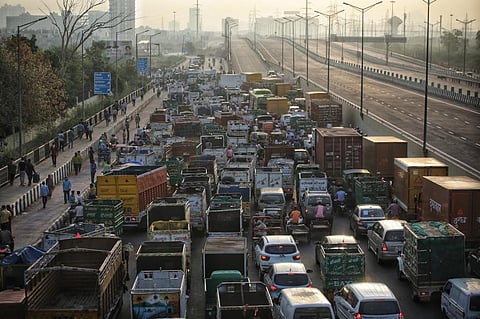

Traffic mobility in the national capital bounced back after the lockdown to curb the spread of the novel coronavirus disease (COVID-19) was lifted. But the city is not prepared for changes needed to cut down the volume of traffic.
New-Delhi based non-profit Centre for Science and Environment (CSE) released an analysis of mobility trends in pre-lockdown, lockdown and post-lockdown periods in Delhi. It tracked the change with the help of data from the Google Mobility Report on different categories of visits classified as retail and recreation, groceries and pharmacies, parks, transit stations, workplaces as well as residential.
CSE also tracked the traffic speed data from Google as a proxy to understand the level of congestion that has a strong bearing on vehicular pollution.
The analysis found that the temporary respite from traffic congestion and air pollution was possible due to shutdown of all economic activity during the lockdown, but it could not be sustained.
The analysis found that the post-lockdown travel recovery was close to normal but did not fully regain the pre-lockdown levels. Grocery trips and workplace trips, for example, recovered the most by November-end and were now only about 15 per cent lower than the pre-lockdown phase. Trips to groceries and pharmacies had reduced by more than 70 per cent in the lockdown phase.
Losing the gains
CSE’s analysis showed that the overall traffic speed, which had improved dramatically during the lockdown, gradually increased with the reopening of the economy.
The mean travel speed on the city’s 12 major stretches increased from 24 kilometres per hour pre-lockdown to 46 kmph during lockdown. This was an increase of 90 per cent.
But this reduced again to 29 kmph (36 per cent decrease) during post lockdown.
During peak hours, travel speed on the selected stretches increased from 23 kmph pre-lockdown to 44 kmph during lockdown (89 per cent increase). But this reduced to 27 kmph (38 per cent decrease) during post lockdown.
And post lockdown, the speeds reduced the by an average 42 per cent compared to during lockdown (lower than any other time in the first half), according to the analysis.
The analysis also noted that the spike in traffic congestion is despite a low public transport ridership and inadequate transport options. It added that public transport is expected to be further constrained by the social distancing norms.
According to the latest media reports, Delhi metro ridership reached only 9-10 lakh daily, as opposed to the 55-60 lakh journeys that the service was recording in the pre-pandemic phase.
According to the analysis:
“The scale and scope of action needed to transform public transportation, walking and cycling options and vehicle restraint measures like city-wide implementation of the parking management area plan and the notified parking rules have remained limited and inadequate. Studies in Delhi have shown that vehicles contribute about 40 per cent of the total pollution load in the city,” said Anumita Roychowdhury, CSE executive director-research and advocacy.